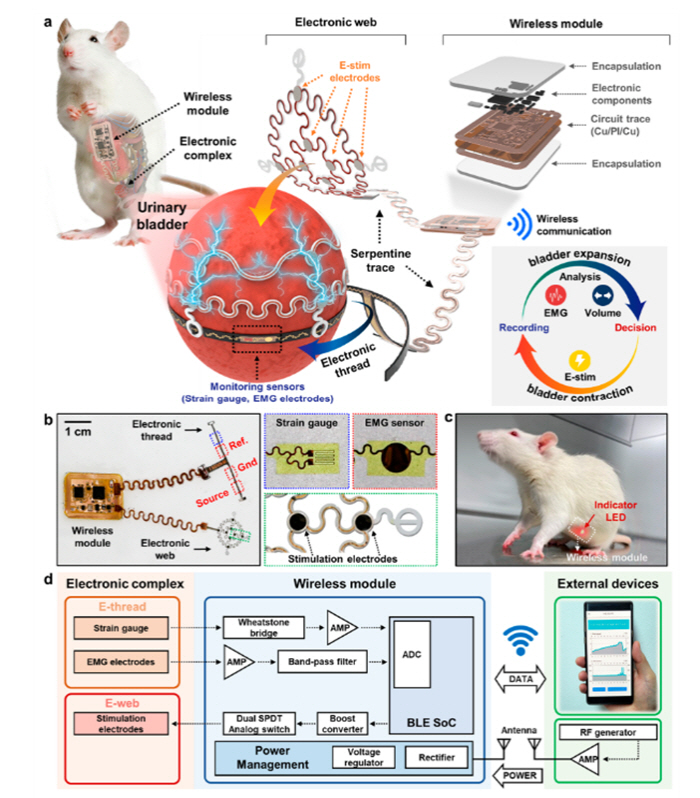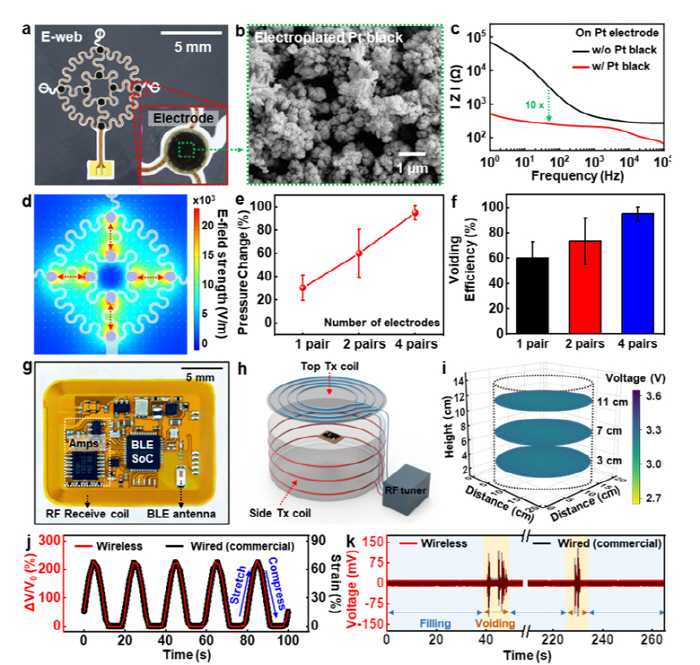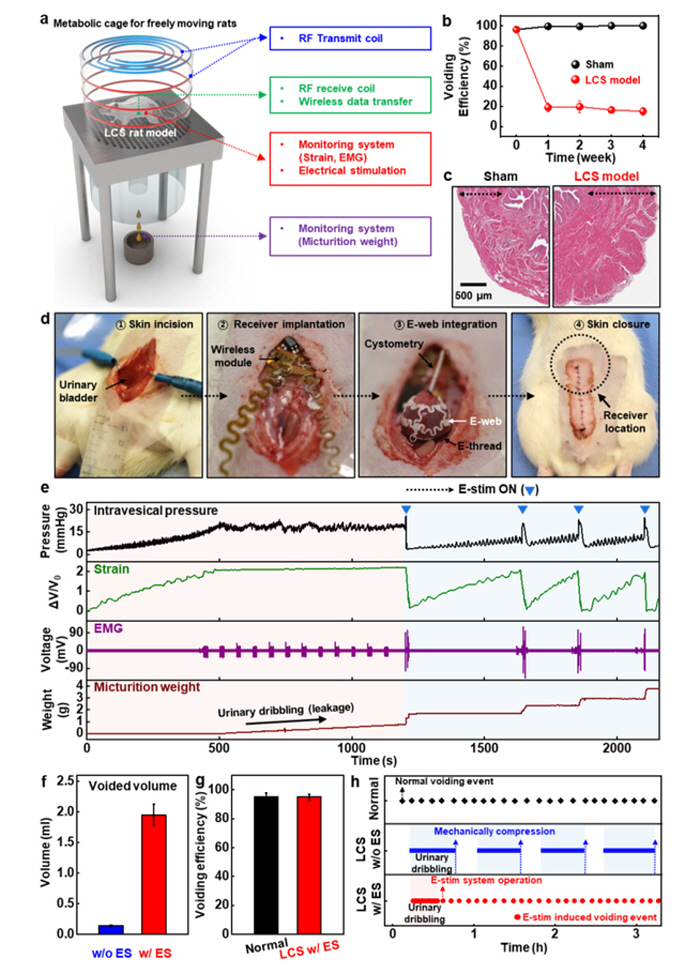Implanted electronic system can treat urinary disorders
An implantable device was developed for real-time analysis and regulation of bladder activities and wireless treatment of urinary disorders
The research findings by the team led by Professor Hwang Seok-won's team were published in ACS Nano

▲ (From left) Lee Joong-hoon, Researcher at SK hynix (Ph.D. from Korea University); Jang Tae-min, Ph.D. candidate at KU-KIST Graduate School of Converging Science and Technology; Shin Jeong-woong, Ph.D. candidate at KU-KIST Graduate School of Converging Science and Technology; and Hwang Suk-won, Professor at KU-KIST Graduate School of Converging Science and Technology
Professor Hwang Suk-won's research team at KU-KIST Graduate School of Converging Science and Technology, in collaboration with a research team from Soonchunhyang University, has successfully developed an implantable device aimed at providing a permanent treatment for urinary disorders. This innovative approach utilizes a soft and highly flexible biocompatible electronic device that is directly applied to the surface of the bladder. The device allows for the wireless monitoring and regulation of bladder activity through its integrated wireless technology.
The research results were published online on April 18 in the prestigious scientific journal ACS Nano (IF=18.03).
* Paper Title : Fully implantable and Expandable Electronic System for Bidirectional Electrical Neuromodulation of the Urinary Bladder
The research team combined various sensors and electrical stimulation (E-stim) systems into a safe, soft, and highly flexible web structure. This E-web was stably applied to a large-volume expandable bladder and integrated with a wireless operating module to create an implanted device. The device was applied to a model of an underactive bladder, a urinary disorder characterized by incomplete emptying of the bladder due to decreased contractility of the bladder muscles or neurological abnormalities. Over an extended period, they analyzed the precise timing of urine discharge by monitoring real-time bladder activity (contraction/dilation muscle signals) wirelessly, and developed a technique involving electrical simulation to facilitate smooth urination.
* Underactive bladder disorder: A condition characterized by reduced contractile strength of the bladder muscles or neurological abnormalities, resulting in difficulties with smooth urine expulsion. This condition leads to incomplete bladder emptying and the presence of a significant amount of residual urine..
One of the current approaches for treating underactive bladders is intermittent self-catheterization. This method involves manually inserting a catheter directly into the urethra to drain urine. However, this approach is associated with considerable discomfort and requires 4-6 catheterizations throughout the day, significantly reducing patients' quality of life. Moreover, it carries the risk of secondary complications such as urinary tract infections and sepsis. For this condition, however, proven effective pharmaceutical and surgical treatments other than catheterization are insufficient. Therefore, the technology developed by the research team, which enables the real-time monitoring of bladder function and E-stim to void urine, represents a groundbreaking approach to the diagnosis and treatment of bladder disorders since it can enhance patient quality of life and alleviate the burden of complications.
The implantable electronic device developed in this study to address bladder urinary disorders is constructed in a web structure (E-web) using a biocompatible and flexible material. It securely attaches to the surface of the highly expandable bladder and integrates various sensors and E-stim systems in a serpentine shape that can stretch and conform to the bladder's irregular surface. This design allows for accurate measurement of bladder status and effective control of urinary function. The web structure, along with the integrated electronic components, is designed to encase the entire bladder, eliminating the need for sutures or adhesives and ensuring stable operation on the bladder surface. One noteworthy feature is the integration of a wireless operating module, which transforms the device into an implantable platform. This wireless functionality offers the advantage of managing and treating urinary disorders without the need for physical connections, reducing patient discomfort.
By strategically arranging a total of eight electrodes in a web structure at consistent intervals, the team achieved uniform and reliable stimulation across the entire bladder surface. This stimulation proved effective in inducing contractions of the bladder muscles.
The module employed in this study is equipped with circuits capable of both receiving power and transmitting and receiving data wirelessly. This design enables the entire system to be fully implanted inside the body without causing any disruption to the patient's daily activities. The module is characterized by its ability to wirelessly transmit bladder status measurements to external devices such as smartphones and to execute electrical simulation commands to regulate bladder function. Furthermore, it operates continuously without the need for a battery as it can receive power through the integrated coil-shaped antenna.
Professor Hwang stated, “The combination of a flexible electronic device with wireless technology in this research outcome offers tremendous potential as a foundational technology for tackling urinary disorders, which have lacked effective treatment methods thus far. By merging the fields of engineering and medical research, we envision that this technology has the potential to revolutionize the diagnosis and treatment of not only bladder-related conditions but also chronic diseases affecting different organs.”
The study was conducted with the support of the Korea Research Foundation's Mid-career Researcher Program, inter-ministry long-term medical device research and development project, and the ICT Convergence Talent Cultivation Program of the IITP (Institute for Information & Communications Technology Planning & Evaluation).
[ Description of Figures ]

▲ Figure 1. a. Schematic illustration of the developed device. The complex consists of an E-web and electronic thread, which securely attaches to the bladder. The latter contains sensors to monitor the bladder's condition (contraction/expansion and muscle signals) while the former is integrated with an electrode array for E-stim. The wireless module connected to the electronic device attached to the bladder includes a circuit capable of both wireless power transmission and wireless data communication. The entire device continuously monitors the bladder, analyzes urine accumulation beyond a certain threshold, and induces bladder voiding through E-stim. b. Images of the complete device and individual components. c. Image of a rat implanted with the entire device. The red LED indicates device activation. d. Functional block diagram of the flow among the electronic complex (left), wireless module (middle), and external device (right).

▲ Figure 2. a. Optical image of the E-web with eight electrodeposited platinum (Pt) black electrodes. b. Scanning electron microscope (SEM) image showing the porous structure of Pt black. c. Impedance characteristics of the E-stim electrodes with and without Pt black. d. Simulation results of E-stim intensity for the two-dimensional configuration of the E-web. e, f. In vivo measurements of pressure (e) and voiding efficiency (f) of the bladder in animal models induced by E-stim with different numbers of electrodes. g. Wireless modules and other electronic components for measurement and regulation of urinary bladder functions. h. Schematic illustration of the experimental cage with two primary antennas for in vivo studies. i. Spatial mapping of regulated voltage distribution in the arena. j. Measured strain values via a wireless mode under repetitive stretching and compressing cycles as compared to ones by a standard component. k. Comparison of measured electrical potentials from EMG electrodes and a commercial product (black) with physiological motions of the urinary bladder.

▲ Figure 3. a. Illustration of the experimental design for animal testing of the developed device. b, c. Evaluations of voiding efficiency (b) and histological examinations of the urinary bladder (c) in sham and disease (LCS model) groups. d. Surgical procedure for a fully implanted electronic complex e. Comprehensive data set collected from a pressure transducer in intravesical pressure, strain, EMG, and micturition weight before and after E-stim using a customized algorithm. f. Quantitative analysis of voided volumes in LCS rats without and with E-stim. g. Voiding efficiency of LCS rats applied with E-stim, compared to the normal group. h. Results of voiding events of normal and LCS rats with and without E-stim.



